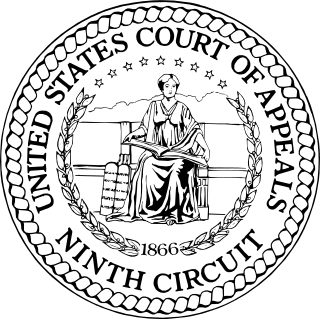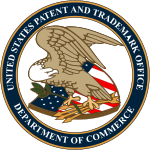A trademark is a word, phrase, or logo that identifies the source of goods or services. Trademark law protects a business' commercial identity or brand by discouraging other businesses from adopting a name or logo that is "confusingly similar" to an existing trademark. The goal is to allow consumers to easily identify the producers of goods and services and avoid confusion.
A colour trade mark is a non-conventional trade mark where at least one colour is used to perform the trade mark function of uniquely identifying the commercial origin of products or services.
Nominative use, also "nominative fair use", is a legal doctrine that provides an affirmative defense to trademark infringement as enunciated by the United States Ninth Circuit, by which a person may use the trademark of another as a reference to describe the other product, or to compare it to their own. Nominative use may be considered to be either related to, or a type of "trademark fair use". All "trademark fair use" doctrines, however classified, are distinct from the fair use doctrine in copyright law. However, the fair use of a trademark may be protected under copyright laws depending on the complexity or creativity of the mark as a design logo.

Pro-Football, Inc. v. Harjo, 415 F.3d 44, is a case in which the U.S. Court of Appeals for the District of Columbia considered the decision of the United States Patent and Trademark Office's Trademark Trial and Appeal Board (TTAB) to cancel the registration of the Washington Redskins football team, based on the claim that the name was disparaging to Native Americans. The Court of Appeals did not actually reach the merits of the TTAB's decision; it sent the case back to the trial court for consideration of a procedural issue.

A concurrent use registration, in United States trademark law, is a federal trademark registration of the same trademark to two or more unrelated parties, with each party having a registration limited to a distinct geographic area. Such a registration is achieved by filing a concurrent use application and then prevailing in a concurrent use proceeding before the Trademark Trial and Appeal Board ("TTAB"), which is a judicial body within the United States Patent and Trademark Office ("USPTO"). A concurrent use application may be filed with respect to a trademark which is already registered or otherwise in use by another party, but may be allowed to go forward based on the assertion that the existing use can co-exist with the new registration without causing consumer confusion.
In United States trademark law, the functionality doctrine prevents manufacturers from protecting specific features of a product by means of trademark law. There are two branches of the functionality doctrine: utilitarian functionality and aesthetic functionality. The rationale behind functionality doctrine is that product markets would not be truly competitive if newcomers could not make a product with a feature that consumers demand. Utilitarian functionality provides grounds to deny federal trademark protection to product features which do something useful. Patent law, not trademark, protects useful processes, machines, and material inventions. Patented designs are presumed to be functional until proven otherwise. Aesthetic functionality provides grounds to deny trademark protection to design features which are included to make the product more aesthetically appealing and commercially desirable. Aesthetic features are within the purview of copyright law, which provides protection to creative and original works of authorship.
In the United States, trademark law includes a fair use defense, sometimes called "trademark fair use" to distinguish it from the better-known fair use doctrine in copyright. Fair use of trademarks is more limited than that which exists in the context of copyright.

Wrenn v. Boy Scouts of America, No. 3:03-cv-04057, was a case before the United States District Court for the Northern District of California; Wrenn asked for the cancellation of federal trademark registrations of the Boy Scouts of America.
Trademark distinctiveness is an important concept in the law governing trademarks and service marks. A trademark may be eligible for registration, or registrable, if it performs the essential trademark function, and has distinctive character. Registrability can be understood as a continuum, with "inherently distinctive" marks at one end, "generic" and "descriptive" marks with no distinctive character at the other end, and "suggestive" and "arbitrary" marks lying between these two points. "Descriptive" marks must acquire distinctiveness through secondary meaning—consumers have come to recognize the mark as a source indicator—to be protectable. "Generic" terms are used to refer to the product or service itself and cannot be used as trademarks.

A trademark is a type of intellectual property consisting of a recognizable sign, design, or expression which identifies products or services of a particular source from those of others, although trademarks used to identify services are usually called service marks. The trademark owner can be an individual, business organization, or any legal entity. A trademark may be located on a package, a label, a voucher, or on the product itself. For the sake of corporate identity, trademarks are often displayed on company buildings. It is legally recognized as a type of intellectual property.
Questions over personal jurisdiction over foreign defendants in the United States arise when foreign nationals commit crimes against Americans, or when a person from or in a different country is sued in U.S. courts, or when events took place in another country. Such cases arise when crimes are committed on the high seas or on international flights, when crimes are alleged to be committed by or against Americans in foreign countries, or when crimes are committed by foreigners against Americans. The Internet also allows computer crime to cross international boundaries.
Initial Interest Confusion is a legal doctrine under trademark law that permits a finding of infringement when there is temporary confusion that is dispelled before the purchase is made. Generally, trademark infringement is based on the likelihood of confusion for a consumer in the marketplace. This likelihood is typically determined using a multi-factor test that includes factors like the strength of the mark and evidence of any actual confusion. However, trademark infringement that relies on Initial Interest Confusion does not require a likelihood of confusion at the time of sale; the mark must only capture the consumer's initial attention.

The case Brookfield Communications, Inc. v. West Coast Entertainment Corporation, 174 F.3d 1036, heard by the United States Court of Appeals for the Ninth Circuit, established that trademark infringement could occur through the use of trademarked terms in the HTML metatags of web pages when initial interest confusion was likely to result.
Inwood Laboratories Inc. v. Ives Laboratories, Inc., 456 U.S. 844 (1982), is a United States Supreme Court case, in which the Court confirmed the application of and set out a test for contributory trademark liability under § 32 of the Lanham Act.

Palm Bay Imports, Inc. v. Veuve Clicquot Ponsardin Maison Fondee en 1772, 396 F.3d 1369, was a case decided by the United States Court of Appeals for the Federal Circuit clarifying the doctrine of foreign equivalents. The court explained that there is a threshold limitation to applying the doctrine of foreign equivalents. The doctrine "should be applied only when it is likely that the ordinary American purchaser would 'stop and translate [the word] into its English equivalent.'"
Ugg boots trademark disputes are the disputes between some footwear manufacturers, as to whether "ugg" is a protected trademark, or a generic term and thus ineligible for trademark protection. In Australia and New Zealand, where "Ugg" is a generic term for the style of footwear, 702 registered trademarks include the term "Ugg" in various logos and designs. By contrast, UGG is a registered trademark of the California-based company Deckers Outdoor Corporation in over 130 countries worldwide, including the U.S., the European Union, and China.

In United States trademark law, Abercrombie & Fitch Co. v. Hunting World, 537 F.2d 4 established the spectrum of trademark distinctiveness in the US, breaking trademarks into classes which are accorded differing degrees of protection. Courts often speak of marks falling along the following "spectrum of distinctiveness," also known within the US as the "Abercrombie classification" or "Abercrombie factors". The lawsuit was brought by Abercrombie & Fitch Co. against Hunting World, Inc. regarding Abercrombie's trademark on the word "Safari", and resulting in Abercrombie's loss of the trademark.

Lens.com, Inc. v. 1-800 Contacts, Inc., 686 F.3d 1376, is a decision by the United States Court of Appeals for the Federal Circuit which ruled that when software merely acts as a "conduit" for providing services over the internet, and does not have an independent value per se, it does not constitute a "good" being "sold or transported in commerce" for the purposes of establishing whether or not a trademark for "computer software" has been "abandoned" under 15 U.S.C. § 1064 and 15 U.S.C. § 1127

Rosetta Stone v. Google, 676 F.3d 144, was a decision of the United States Court of Appeals for the Fourth Circuit that challenged the legality of Google's AdWords program. The Court overturned a grant of summary judgment for Google that had held Google AdWords was not a violation of trademark law.
The reverse doctrine of equivalents is a legal doctrine of United States patent law, according to which a device that appears to literally infringe a patent claim, by including elements or limitations that correspond to each element or limitation of the patent claim, nonetheless does not infringe the patent, because the accused device operates on a different principle. That is, "it performs the same or a similar function in a substantially different way." It has been said that "the purpose of the ‘reverse’ doctrine is to prevent unwarranted extension of the claims beyond a fair scope of the patentee’s invention."








